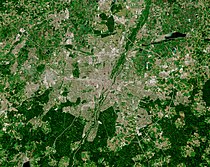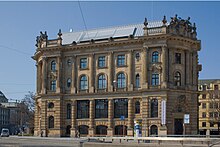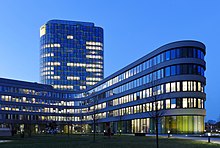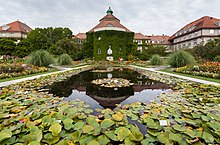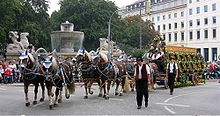Munich
Munich (in German, München, pronounced/хm/nçn//(![]() listen)in Austria Minga) is the capital of the federated state of Bavaria and the third city of Germany by number of inhabitants, and the eleventh of the European Union.
listen)in Austria Minga) is the capital of the federated state of Bavaria and the third city of Germany by number of inhabitants, and the eleventh of the European Union.
In addition, it is the German city where the most companies are found in the DAX stock index, the region being an important economic engine of the financial, technological, automotive, and service industries. Companies with global headquarters in Munich include Allianz, BMW, BSH, FlixBus, Infineon, MAN, MTU, Munich RE, Osram, Sixt, the Siemens group, and TÜV SÜD. Based on the renowned study and list of Countries with the highest quality of life in the world by Mercer in 2019, Munich is the city with the highest quality of life in Germany, as well as the third in the world, prominent world position in which the study coincided in the same year Monocle's Quality of Life 2019.
The city lies on the Isar River, north of the Bavarian Alps. The city's motto is München mag Dich (Munich likes you). Before 2006 it was Weltstadt mit Herz (Cosmopolitan City with Heart). Its name, München, derives from Old High German Munichen, meaning "in the place of the monks". The name of the city comes from the Benedictine monks who founded the city; hence, on the city's coat of arms there is a monk. The official colors of the city are black and gold, colors of the Holy Roman Empire, since the time of Emperor Louis IV of Bavaria.
Modern Munich is a financial and publishing center. In terms of social and economic innovation, the city ranks 15th out of 289 cities according to a 2010 study, and is the fifth German city for the 2thinknow Innovation Cities Index based on an analysis of 162 indicators.
Toponymy
The name of the city in Spanish, an exonym, is Munich (AFI: ['mu.nitʃ ], also [ˈmu.nik). Therefore, the pronunciation of the exonym is, etymologically, [ˈmunik], through the pronunciation of the exonym in English, or ['munitʃ], following the usual Spanish pronunciation rules. The demonym is "muniqués" and its plural, "muniqueses". The Pan-Hispanic Dictionary of Dudes advises against pronunciation with a dipthong [ˈmiunik], typical of English.
In German the toponymous is München (pronounced/ ISSN/(![]() listen)and austro-bavaro Minga (pronounced[шm strung(ed)]]).
listen)and austro-bavaro Minga (pronounced[шm strung(ed)]]).
History
The city of Munich was founded by Henry the Lion, Duke of Bavaria and Saxony.
After a fire, the city was rebuilt by the Holy Roman Emperor. During the Thirty Years' War, the king of Sweden took the city.
At the beginning of the XIX century the city, like the rest of Bavaria, became part of the Confederation of the Rhine fostered by Napoleon I. After the collapse of the Napoleonic Empire, Bavaria joined the German Confederation.
During the reigns of Maximilian I, Louis I, Maximilian II, Louis II, and the regency of Prince Leopold, architecture and the arts in the city flourished like never before.
After the German victory in the Franco-Prussian War, led by Otto von Bismarck, Bavaria and with it Munich became part of the German Empire.
At the end of World War I, Munich became the focus of major movements rejecting the peace conditions imposed on Germany by the Treaty of Versailles. In this context, the "Munich Putsch" took place in 1923, an uprising led by Adolf Hitler.
In 1938, representatives of France, the United Kingdom, and Germany signed the Munich Agreement, ceding the Sudetenland to Germany.
During World War II, Munich was badly damaged. However, in the decades since the conflict it has been carefully rebuilt. After the war, Bavaria was integrated into the Federal Republic of Germany.
In this city, in 1962, a meeting of Spaniards critical of the Franco regime was held, contemptuously called the Munich Conspiracy.
The so-called Munich massacre in 1972 took place during the XX edition of the Summer Olympic Games. That day a command of Palestinian terrorists called Black September took eleven members of the Israeli Olympic team hostage. The tragedy was seen around the world on television.
Demographics
The population of the city of Munich was only 24,000 in 1700, but in subsequent years it doubled every thirty years, and the population exceeded 100,000 in 1852, when it was classified as a great city (Großstadt) by German administrative regulations. In 1883 Munich had a population of about 250,000, which doubled to 500,000 in 1901, making Munich the third largest city in the German Reich after Berlin and Hamburg.
The physical effects of World War II are clearly visible. By the end of the war, 90% of the historic center had been destroyed in 73 air raids and half the city was in ruins. Estimates for the impact of these incursions on the population offer the figure of 6,000 deaths. In total, Munich lost 34% of its population, with 279,000 people displaced through evacuation, migration, deportation, and made homeless through air raids. The total population fell from 829,000 in May 1939 to 550,000 in May 1945. The pre-war population level did not recover until 1950.
Shortly before the city's 800th anniversary, on December 15, 1957, the millionth resident of the city of Munich was born, making Munich the last to reach the population of one million among the top 70 cities in everyone. According to the Bavarian National Office for Statistics and Data Processing, the official population figure for Munich was 1,561,094 as of March 2021 (main residences only and with adjustments from other national offices).
The following summary shows the population according to local historical data, only residents and excluding those who work in your area.
| Graph of demographic evolution in Munich between 1800 and present |
 |
Source: Bavarian state office for statistics and data processing |
Government and politics

1Altstadt-Lehel
2.Ludwigsvorstadt-Isarvorstadt
3Maxvorstadt
4.Schwabing-West
5Au-Haidhausen
6Sendling
7Sendling-Westpark
8.Schwanthalerhöhe
9.Neuhausen-Nymphenburg
10Moosach
11.Milbertshofen-Am Hart
12Schwabing-Freimann
13Bogenhausen
14Berg am Laim
15.Trudering-Riem
16Ramersdorf-Perlach
17.Obergiesing
18Untergiesing-Harlaching
19.Fürstenried-Solln
20Hadern
21.Pasing-Obermenzing
22.Aubing
23Allach-Untermenzing
24Feldmoching-Hasenbergl
25Laim
Munich is the seat of the Bavarian parliament and government due to its status as the capital of Bavaria. In addition, it is also the capital of the Oberbayern region and its administrative district (Landkreis München). Other state bodies with federal and international coverage also have their headquarters in the city, such as the European Patent Office or the Federal Court of Finance (Bundesfinanzhof).
Traditionally, center-left parties such as the SPD have dominated local politics, while in Bavaria the center-right, hand in hand with the CSU, tends to rule. The current mayor of Munich is the Social Democrat Dieter Reiter.
Munich is divided into 25 districts.
Geography
The city is crossed by the river Isar in southern Germany.
Its highest point is the Warnberg, located in the 19th district (Thalkirchen-Obersendling-Forstenried-Fürstenried-Solln), with a height of 519 m. The lowest point, 492 m, is to the north, in the Feldmoching district.
The Isar River runs through the city for a total of 13.7 km, entering it from the southwest and leaving it from the northeast. There are several islands in the river, such as the Museumsinsel (Museum Island), so called because the Deutsches Museum (Museum of the History of German Science and Technology) is located on it, or the nearby Praterinsel.
Around the city there are numerous lakes, of which we can highlight: the Ammersee, the Wörthsee and the Starnberger See.
The river Würm has its origin in this last lake, which together with the Hachinger Bach and the various channels of the river Isar bathe the city. But even so, most of the branches of the Isar River that passed through the center were channeled or even dried up due to the metro and railway works.
Climate
According to the Köppen classification, Munich is located in a transition zone between the humid temperate climate (Cfb) and the continental humid climate (Dfb). strongly influenced by its proximity to the Alps. The altitude of the city and its proximity to the northern edge of the Alps causes an increase in rainfall for a good part of the year.
Storms often come violently and unexpectedly. The temperature range between day and night can be extreme. A warm wind from the Alps (Föhn Wind) can sharply increase temperatures within a few hours, even in winter. Winters last from December to March. Munich has extremely cold winters, however, in this season there is very little precipitation in the form of rain. The coldest month is January with an average temperature of -8 °C. Snowfall is usually seen for several weeks during the winter. Summers in the city of Munich are mild, with an average maximum temperature of 24 °C in the hottest month.
| Month | Ene. | Feb. | Mar. | Open up. | May. | Jun. | Jul. | Ago. | Sep. | Oct. | Nov. | Dec. | Annual |
|---|---|---|---|---|---|---|---|---|---|---|---|---|---|
| Temp. max. abs. (°C) | 17.2 | 21.1 | 23.3 | 26.6 | 30.0 | 33.8 | 36.1 | 35.0 | 30.0 | 26.1 | 18.8 | 20.5 | 36.1 |
| Average temperature (°C) | 1.1 | 3.5 | 8.4 | 13.3 | 18.0 | 21.4 | 23.8 | 22.9 | 19.4 | 13.6 | 6.5 | 2.3 | 12.81 |
| Average temperature (°C) | -8.3 | -1.6 | 2.9 | 6.9 | 12.2 | 15.4 | 19.3 | 16.6 | 12.4 | 7.4 | 1.7 | -6.9 | 6.7 |
| Temp. medium (°C) | -11.4 | -7.7 | 0.3 | 2.5 | 7.2 | 9.4 | 12.0 | 11.7 | 8.8 | 4.5 | -2.6 | -8.3 | 3.82 |
| Temp. min. abs. (°C) | -26.6 | -22.7 | -15.5 | -6.1 | -2.7 | -2.7 | 3.8 | 3.8 | 0 | -6.1 | -14.4 | -22.0 | -26.6 |
| Total precipitation (mm) | 48.0 | 45.2 | 57.7 | 69.9 | 93.4 | 127.6 | 131.6 | 110.5 | 86.3 | 65.4 | 71.0 | 60.8 | 967.4 |
| Days of rain (≥ 1 mm) | 10.0 | 8.6 | 10.5 | 10.9 | 11.6 | 13.8 | 12.0 | 11.4 | 9.6 | 9.1 | 10.7 | 11.2 | 129.4 |
| Hours of sun | 54 | 84 | 128 | 157 | 199 | 209 | 237 | 213 | 173 | 129 | 69 | 49 | 1701 |
| Relative humidity (%) | 80 | 74 | 62 | 57 | 55 | 58 | 55 | 55 | 61 | 71 | 80 | 81 | 65.75 |
| Source No. 1: World Meteorological Organisation | |||||||||||||
| Source No. 2: «Climate Munich – Bavaria». Archived from the original on 23 March 2012. Consultation on 6 August 2012. | |||||||||||||
Economy
Multinational companies or companies of recognized prestige, with headquarters in Munich:
- ADAC, German Automobile Club.
- Allianz.
- Bayerische Landesbank (known as BayernLB).
- BMW.
- B/S/H/.
- Burda (owner of Xing).
- FlixMobility (FlixBus owner).
- Infineon Technologies.
- MAN.
- MTU.
- Munich RE.
- Patent Europe Office.
- Osram.
- Paulaner.
- Rohde & Schwarz.
- Roland Berger.
- Siemens.
- Sixt AG.
- Süddeutsche Zeitung.
- TÜV SÜD.
- UniCredit Bank AG (known as HVB, HypoVereinsbank).
- Unify.
- Wirecard.
Munich is a modern economic center. BMW (Bayerische Motoren Werke) and Siemens AG have their headquarters here. The local government encourages the development of high-tech industry and research projects in the fields of biology, information technology, aerospace and automotive.
The city and its surroundings constitute one of the regions with the highest concentration of wealth in the world.
One of the important elements of the local and regional economy is the Biergärten, where local and regional inhabitants come and live together, especially during spring and summer.
In recent years, the city's debt has grown to place it above the rest of the German cities since 2005.
The debt per inhabitant then stood at €2,651/inhab. followed by Cologne (€2,571) and by Frankfurt am Main (€23,138).
In return, the city has a great wealth of assets in the form of shares in buildings and homes and in municipal services.
Especially after World War II, several companies that were based in Berlin or the German Democratic Republic moved to Munich.
Infrastructures
Transportation
Like most German cities, Munich has an efficient public transportation system. The company that manages all public transport is the MVV.
Munich's Franz Josef Strauss airport is the second in the country, surpassed only by Frankfurt am Main. To go from the airport to the city center use the Fast Train (lines S1 or S8). They follow different routes to get to the airport, so it is advisable to consult a transport map to choose the most favorable line.
In addition, the subway (U-Bahn), the tram (Tram) and the bus have extensive and punctual lines that make public transport in Munich a delight. For this reason, many Munich residents do without the car and get around by these means of transport or by bicycle (which takes precedence over pedestrians and cars).
Prices are relatively high, so you should find out about passes for one day, three days or seven days, group tickets or the Streifenkarte. From Plaza de María you can take most of the suburban trains (S-Bahn) that take you around Munich and its surroundings and to the airport, but also two metro lines.
Public transport statistics
According to a report by Moovit in July 2017, the average time people spend on public transportation in Munich, for example to and from work, on a weekday is 56 min., while 11% of people spend more than 2 hours every day. The average time people wait at a stop or station is 10 minutes, while 6% of people wait more than 20 minutes each day. The average distance people typically travel in a single trip is 9.2 km, while 21% travel more than 12 km in one direction.
Education
| University | Foundation | Acronym | Type | |
|---|---|---|---|---|
 | University of Munich | 1472 | LMU | Public University |
 | Technical University of Munich | 1868 | TUM | Public University |
Culture
“Between art and beer, Munich is like a town camped on hills,” Heinrich Heine wrote over 150 years ago - a statement that still holds true today. Between the beer festival and the opera, the Hofbräuhaus and the Art Gallery, the BMW and FC Bayern Munich, the city combines strong Bavarian tradition with frenetic economic and social activity. Munich is a city rooted in southern Germany and is internationally known for its collections of ancient and classical art. Therefore, the Alte Pinakothek, Neue Pinakothek, the Pinakothek der Moderne, and the Lenbachhaus are some of the most famous museums in the world. The Deutsches Museum dedicated to science and technology, with more than a million visitors per year, is one of the most visited museums in Europe. The Munich Glyptothek (Glyptothek) contains sculptures, mosaics and reliefs from the Archaic period (650 BC) to Roman times (500 BC). Other museums, but they are also part of the most famous museums in Germany, such as the Völkerkundemuseum (Ethnological Museum), the Bavarian National Museum, the Paläontologisches Museum (presenting the State's prehistoric collection) and the Münchner Stadtmuseum (City Museum). There is also within the city the classical-style National Theater of Munich, which houses the Bavarian State Opera, and the Cuvilliés Theater, which is the most important venue in Rococo architectural style in Germany.
The most important film production companies in Germany are in Munich.
Architecture and urbanism
The architect and urban planner Theodor Fischer envisioned the development of Munich towards the end of the 19th century. His work continues to mark the urban landscape of the city.
The central area of Munich can be crossed from the Central Railway Station (Hauptbahnhof) in an easterly direction, passing through Karlsplatz and Karlstor (Charles Gate) which between 1319 and 1791 served as the gateway to the walled city. Then continue through the pedestrian and commercial area to the Plaza de María (Marienplatz) which since the founding of the city has been the geographical and social center. It is presided over by the New Town Hall (Rathaus) in neo-Gothic style with its famous carillon.
A few steps away is the Cathedral of Our Lady (Frauenkirche), one of the icons of the city, with its two 99-meter-high towers that are visible from miles around, thanks to a law that prevents build buildings taller than the cathedral in the urban area and part of the outskirts. A couple of blocks south is the food market (Viktualienmarkt) which was originally a traditional farmer's market, and today is a very popular market among lovers of good food.
Other religious centers with outstanding architecture are the Church of San Miguel, the Church of the Holy Cross and the Peterskirche, which is the oldest church in the city and has a viewpoint. There is also the Theatinerkirche St. Kajetan, a church with gold-colored towers and a greenish dome.
The city has several parks among which the English Garden (Englischer Garten) stands out, it is the central park of the city crossed by the Eisbach stream. It is one of the largest parks in a city in the world. Also important is the Royal Palace of Munich (Residenz) in the nerve center of the city, as well as the Nymphenburg Palace, former summer residence of the kings of Bavaria.
Gastronomy
Typical are cooked white sausages (Weißwurst), which originated in Munich in 1857. They are made from finely minced veal, lard and spices. It has a light gray color due to not being salted. They are very similar to Wollwurst and Stockwurst. They are traditionally cooked at dawn and eaten in the morning as a snack in the markets and in taverns with sweet mustard, Brezn and wheat beer. The Leberkäs, a kind of hot sausage, is another of the specialties of this city, usually accompanied by a bread roll (Leberkässemmel). Its fundamental characteristic is its box shape that differentiates it from most cooked sausages.
Beer is the most typical drink of the gastronomy of Munich. The most widely drunk is Helles, a low-fermentation beer, but the Weißbier is also well-known, a high-fermentation beer in which 50% of the grain must be wheat.. Duke Guillermo IV of Bavaria promoted the new law that fixed the composition of the beer. This "law of purity" (Reinheitsgebot) is still followed to produce beer. The minimum measure in which Helles are sold is half a liter, both in jug and bottle. On the other hand, in taverns it is common to ask for 1-litre jugs, called Maß, typical of the Bavarian area. Despite the beer purity law, it is very common to consume mixed beers, such as Helles with Zitronenlimonade called Radler which comes from the word cyclist, consists of beer mixed with lemon soda. Other mixes are Colaweisen or Nega, the latter term in Bavaro; is the mix of Weißbier with cola, another unique mix in Munich is to order a Russ which is Weißbier with Zitronenelimonade which comes from the November Revolution of 1917, where the celebrations for the triumph of socialism and the fall of the German monarchy, ended with the beer stocks, having the taverns to mix the beer to lengthen the stocks. The traditional brands of the city are: Löwenbräu, Paulaner, Spatenbräu, Augustiner, Hofbräu and Hacker-Pschorr, all of which have factories in the city.
Sports
Bayern Munich is the most successful soccer club in Germany and the one that has won the Bundesliga the most times.
Two first-class sports centers stand out in the city: the Olympic Park, a 3 km² sports complex built for the Summer Olympic Games in 1972 and the Allianz Arena, an ultra-modern stadium built for the Soccer World Cup 2006. It is also the stadium of TSV 1860 Munich, which currently plays in the 2. Bundesliga.
Events
These are some of the most outstanding cultural activities that regularly take place in the city throughout the year:
- Carnival: Dance of women in the market (Tanz der Marktfrauen) and play activities in the Viktualienmarkt.
- February/March: Festival of strong beer (Starkbierfest), especially at the Nockherberg, headquarters of the Paulaner brewery.
- April: Spring party (Frühlingsfest) at Theresienwiese.
- April/May: Traditional market at the Mariahilfsplatz, called Auer Dult.
- May: Cultural and family festival on May 1st at Marienplatz.
- May: Munich Biennial, international musical theatre show held every two years since 1988.
- May/August: Bladenight, night out on skates.
- May/June: StustaCulum, Germany's largest university festival in Studentenstadt, the country's largest student residence.
- June: Streetlivefestival at Leopoldstraße.
- June: Festival of comics.
- June/July: Tollwood at the Olympiapark.
- July: Christopher Street Day, gay pride day.
- July: Japanese party. It takes place on the third Sunday in the cassette behind the Art House (Haus der Kunst).
- July: Auer Dult.
- July: Bell'Arte Music Festival in the courtyard of the Residenz.
- August: Summer party in the Olympic Park.
- August: Theatron MusikSommer - a month of daily concerts in the Olympic Park. It's free and they play two groups a day.
- August: Summer party at the Viktualienmarkt.
- August: LILALU, children's and circus festival in the Olympic Park.
- September: Streetlivefestival at Leopoldstraße.
- September/October: Oktoberfest, beer party at Theresienwiese (die Wies'n). It attracts visitors from all over the world.
- September/October: Auer Dult.
- November/December: SPIELART, Munich Theater Festival.
- November/January: Tollwood at Theresienwiese.
- December: Christmas Market (Christkindlmärkte).
In addition, special attention must be paid to the Opera festival (Opernfestspiele) and the Film Festival (Filmfest).
Symbols
The city's coat of arms shows in silver a Benedictine monk in a black habit with a gold outline and red shoes. In his left hand he holds an oath book and raises his right to do so.
The current official shield was made in 1957 and is called the small shield. There is also what, on the contrary, is called the large shield, used only on special occasions. In it appears, on a silver background, a red portal with open doors and guarded by two towers with a black and gold striped table. Above the portal is a crowned golden lion. At the door you can see the monk who also appears on the small shield.
The evolution over time of the unofficial representations of the monk that appear on the shield, by different artists, gave rise to the figure of the Munich boy (Münchener Kindl). The central character of the shield becomes the child, from which various graphic representations are derived.
The colors of the city are black and gold, corresponding to the colors of the Holy Roman Empire.
Twinned cities
Twinnings in Munich:
- Edinburgh, Scotland, since 1954.
- Verona (Italy, since 1960).
- Bordeaux (France, since 1964).
- Sapporo (Japan, since 1972).
- Cincinnati (United States, since 1989).
- Kiev (Ukraine, since 1989).
- Harare (Zimbabue, since 1996).
- Be'er Sheva (Israel, since 2021).
Notable people
Contenido relacionado
Demographics of Argentina
Intellectual property
Economy of Luxembourg


